Highway Bridge Infrastructure in the Province of British Columbia (BC), Canada
Abstract
:1. Introduction
2. Research Significance
3. Bridge Inventory Analysis
- There is an increasing trend in the use of concrete bridges compared to steel bridges. After 1970, the percentage of concrete bridges including pre-tensioned and post-tensioned concrete bridges increases in a rapid manner, which is also a common phenomenon in other regions of Canada considering the high construction cost and difficulties in the maintenance of steel bridges.
- Almost 70% of timber bridges are constructed from 1960 to 1980 after which a gradual decrease can be observed in using timber as a construction material for bridges in BC.
4. Bridge Class Parameter
4.1. Total Bridge Length and Maximum Span Length
- Almost 90% of multispan concrete box girder bridges (MSBG Concrete) have a total bridge length of 10–90 m whereas for multispan concrete girder bridges (MSG Concrete) 90% of them lie within a range of 20–120 m. Among the four types of multispan concrete bridges (Table 3), multispan simply supported girder bridges (MSSG) form the longest with a maximum length of 1200 m.
- Similar estimations can be made for maximum span length. While 90% of the MSBG concrete bridges have a maximum span length of 10–20 m, the range for 90% MSG concrete bridge is 20–40 m.
- Single span bridges are much smaller than other category bridges where most of them are covered within a range of 10–60 m. Among these five types of bridges, single span truss bridges are the longest ones.
- Multispan steel bridges comprise the longest bridges of all the categories considering 70% of the steel bridges have a span length ranging from 100–300 m. Steel bridges cover a large variety of span lengths from 20–60 m.
4.2. Number of Bridge Spans
- For all bridge types except for simply supported concrete box girder bridges (MSBG Concrete), most are constructed with three spans. For the MSBG Concrete bridge class, bridges with double span are most common.
- Timber girder bridges are generally comprised of a higher number of span with smaller span lengths.
4.3. Deck Width
4.4. Skew Angle
- Steel truss bridges are mainly non-skewed bridges with a very few exceptions.
- For skewed concrete girder bridges, most of them have a skew angle that lies between 16–30°.
- Steel and timber girder bridges are less skewed than the concrete girder bridges, however, it is not uncommon for these bridges to have skew angle more than 45°.
4.5. Year of Construction
- From the sudden steep slope of the CDF of timber girder bridges (mid portion of Figure 9d), it can be summarized that most of the timber bridges were constructed within the period of 1970–1980 whereas after 1980, the slope flattens indicating a significant reduction in timber bridge construction.
- Since 1980, an increase in the number of concrete bridges is noteworthy (Figure 9b). After 1980, there was a decreasing trend in the steel bridges, especially for steel truss bridges. Steel truss bridges are much older compared to the other steel bridge types.
4.6. Bridge Condition Index (BCI)
- Almost 95% of the bridges are assigned with a BCI value equal to or less than 3.0, which indicates the absence of any significant damage in the bridges in BC.
- Only 0.04% of the total 2815 bridges has suffered serious damage and needed immediate repair.
4.7. Bridge Pier and Foundation Type
- Most of the concrete girder and steel girder bridges are constructed with multi column bent piers, whereas pile bent types are mostly associated with concrete box girder bridges.
- Steel bent and timber piers are typical to steel bridges and timber girder bridges, respectively, however, for the steel bridge type, concrete wall piers seemed to be preferred.
- The most common foundation types that were widely used for the construction of BC highway bridges are also listed in Table 8 along with their associated pier types.
- For bridges with single column, flared column, and multicolumn bent pier types, single column footing was always the preferred option.
- For bridges with pile bent with or without concrete diaphragm, the steel pipe pile is the most common among other available pile types such as concrete pile, steel H pile, and log pile. For different type of wall piers, steel H pile and steel pipe pile have been the best matches, unless the soil condition is good for shallow wall footing.
5. Application of Bridge Inventory Data
6. Final Considerations
- A total number of 2555 bridges have been identified and are classified into 13 typical bridge classes, which represent almost 96% of total highway bridges in the region. Among those major categories of bridges, timber girder bridges comprise more than 29% of all bridges whereas concrete girder and concrete box girder bridge types comprise 24% and 22.5% of all highway bridges in the province, respectively.
- Different structural and geometrical properties required to describe a comprehensive bridge type are also presented here which include total length and maximum span length of the bridge, deck width, number of spans, skew angle, construction type and materials used, pier and foundation type, year of their construction, structural condition rating, and location of the bridges. An in-depth analysis of the inventory has been carried out for better representation of the available data and to make essential judgments.
- While considering the age of the existing bridges, it can be concluded that 50% of the bridges from the inventory were constructed more than 35 years ago. Other statistics show that the timber girder bridges and steel bridges are considerably older compared to the concrete bridges, which indicates that the modern bridges are mostly being built with reinforced concrete.
- In general, the majority of bridges have a BCI rating between 2–2.5 which indicates a condition state that does not require immediate attention, and very few, almost less than 1%, suffer from serious defects that need immediate repair or replacement. Since most timber and steel bridges are older, they have higher BCI rating than the others.
- The inventory includes bridges that have a total length of less than 4 m to bridges over 1800 m. Almost 80% of them are within the range of 20–100 m. The number varies from 5 m to 40 m in the case of single span bridges. For multispan bridges, three spans are the most frequent except for the simply supported concrete box girder bridge type, which is mostly comprised of two span bridges.
- In BC, highway bridges with multi-column bent and timber piers are most common which comprise almost 21.89% and 21.04%, respectively, of all the bridges in the inventory. While looking into the foundation types, steel pipe pile and steel H pile are the dominating types.
Acknowledgments
Author Contributions
Conflicts of Interest
References
- Chang, S.E.; Nojima, N. Measuring post-disaster transportation system performance: The 1995 Kobe earthquake in comparative perspective. Transp. Res. Part A Policy Pract. 2001, 35, 475–494. [Google Scholar] [CrossRef]
- Cho, S.; Gordon, P.; Moore, J.; Richardson, H.; Shinozuka, M.; Chang, S. Integrating transportation network and regional economic models to estimate the costs of a large urban earthquake. J. Reg. Sci. 2001, 41, 39–65. [Google Scholar] [CrossRef]
- Padgett, J.; DesRoches, R. Bridge functionality relationships for improved seismic risk assessment of transportation networks. Earthq. Spectra 2007, 23, 115–130. [Google Scholar] [CrossRef]
- Billah, A.; Alam, M.; Bhuiyan, M. Fragility analysis of retrofitted multicolumn bridge bent subjected to near-fault and far-field ground motion. J. Bridge Eng. 2013, 18, 992–1004. [Google Scholar] [CrossRef]
- Jennings, P.C. Engineering Features of the San Fernando Earthquake of February 9, 1971; Report No. EERL-71-02; Earthquake Engineering Research Laboratory, California Institute of Technology: Pasadena, CA, USA, 1971. [Google Scholar]
- Mitchell, D.; Tinawi, R.; Sexsmith, R.G. Performance of bridges in the 1989 Loma Prieta earthquake, Lessons for Canadian designers. Can. J. Civ. Eng. 1991, 18, 711–734. [Google Scholar] [CrossRef]
- Basoz, N.I.; Kiremidjian, A.S.; King, S.A.; Law, K.H. Statistical analysis of bridge damage data from the 1994 Northridge, CA earthquake. Earthq. Spectra EERI 1999, 15, 25–53. [Google Scholar] [CrossRef]
- Bruneau, M.; Wilson, J.W.; Tremblay, R. Performance of steel bridges during the 1995 Hyogo-ken Nanbu (Kobe, Japan) earthquake. Can. J. Civ. Eng. 1996, 23, 678–713. [Google Scholar] [CrossRef]
- Chang, K.C.; Chang, D.W.; Tsai, M.H.; Sung, Y.C. Seismic performance of highway bridges. Earthq. Eng. Eng. Seismol. 2001, 2, 55–77. [Google Scholar]
- Hsu, Y.; Fu, C. Seismic effect on highway bridges in Chi Chi earthquake. J. Perform. Constr. Facil. 2004, 18, 47–53. [Google Scholar] [CrossRef]
- Kawashima, K.; Unjoh, S.; Hoshikuma, J.I.; Kosa, K. Damage of Bridges due to the 2010 Maule, Chile. Earthq. J. Earthq. Eng. 2011, 15, 1036–1068. [Google Scholar] [CrossRef]
- Mitchell, D.; Huffman, S.; Tremblay, R.; Saatcioglu, M.; Palermo, D.; Tinawi, R.; Lau, D. Damage to bridges due to the 27 February 2010 Chile earthquake. Can. J. Civ. Eng. 2012, 39, 675–692. [Google Scholar]
- Mander, J.B. Fragility curve development for assessing the seismic vulnerability of highway bridges. In Research Progress and Accomplishments: 1997–1999; Stoyle, J.E., Ed.; Multidisciplinary Center for Earthquake Engineering Research (MCEER): Buffalo, NY, USA; pp. 89–98.
- Choi, E.; DesRoches, R.; Nielson, B. Seismic fragility of typical bridges in moderate seismic zones. Eng. Struct. 2004, 26, 187–199. [Google Scholar] [CrossRef]
- Pan, Y.; Agrawal, A.; Ghosn, M. Seismic Fragility of Continuous Steel Highway Bridges in New York State. J. Bridge Eng. 2007, 12, 689–699. [Google Scholar] [CrossRef]
- Bignell, J.; James, L. Analytical fragility analysis of southern Illinois wall pier supported highway bridges. Earthq. Eng. Struct. Dyn. 2010, 39, 709–729. [Google Scholar] [CrossRef]
- Alam, M.S.; Bhuiyan, M.A.R.; Billah, A.H.M.M. Seismic fragility assessment of SMA-bar restrained multi-span continuous highway bridge isolated by different laminated rubber bearings in medium to strong seismic risk zones. Bull. Earthq. Eng. 2012, 10, 1885–1909. [Google Scholar] [CrossRef]
- Tavares, D.H.; Suescun, J.R.; Paultre, P.; Padgett, J.E. Seismic fragility of a highway bridge in Quebec. J. Bridge Eng. 2013, 18, 1131–1139. [Google Scholar] [CrossRef]
- Decò, A.; Bocchini, P.; Frangopol, D.M. A probabilistic approach for the prediction of seismic resilience of bridges. Earthq. Eng. Struct. Dyn. 2013, 42, 1469–1487. [Google Scholar] [CrossRef]
- Cimellaro, G.P.; Reinhorn, A.M.; Bruneau, M. Framework for analytical quantification of disaster resilience. Eng. Struct. 2010, 32, 3639–3649. [Google Scholar] [CrossRef]
- Hedayati Dezfuli, F.; Alam, M.S. Seismic vulnerability assessment of a steel-girder highway bridge equipped with different SMA wire-based smart elastomeric isolators. Smart Mater. Struct. IOP 2016, 25, 075039. [Google Scholar]
- Domaneschi, M.; Martinelli, L. Earthquake-resilience-based control solutions for the extended benchmark cable-stayed bridge. J. Struct. Eng. 2016, 142, C4015009. [Google Scholar] [CrossRef]
- Ando, Y.; Sakakibara, M.; Yamandoe, S.I.; Ohbo, N. Seismic evaluation of actual bridge with isolators by vibration tests. In Proceedings of the Second World Conference on Structural Control, Kyoto, Japan, 28 June–1 July 1998; Volume 1, pp. 913–922. [Google Scholar]
- Constantinou, M.C.; Reinhorn, A.M.; Mokha, A.; Watson, R. Displacement control device for base isolation of bridges. Earthq. Spectra 1991, 7, 179–200. [Google Scholar] [CrossRef]
- Wilde, K.; Paolo, G.; Fujino, Y. Base isolation system with shape memory alloy device for elevated highway bridges. Eng. Struct. 2000, 22, 222–229. [Google Scholar] [CrossRef]
- Yang, J.N.; Wu, J.C.; Kawashima, K.; Unjoh, S. Hybrid control of seismic–excited bridge structure. Earthq. Eng. Struct. Dyn. 1995, 24, 1437–1451. [Google Scholar] [CrossRef]
- Housner, G.; Bergman, L.A.; Caughey, T.K.; Chassiakos, A.G.; Claus, R.O.; Masri, S.F.; Skelton, R.E.; Soong, T.T.; Spencer, B.F.; Yao, J.T. Structural control: past, present, and future. J. Eng. Mech. 1997, 123, 897–971. [Google Scholar] [CrossRef]
- Mufti, A. Guidelines for Structural Health Monitoring; ISIS Canada Design Manual; ISIS Canada: Winnipeg, MB, Canada, 2001. [Google Scholar]
- Pines, D.; Aktan, A.E. Status of SHM long span bridges in the United States. Prog. Struct. Eng. Mater. 2002, 4, 372–380. [Google Scholar] [CrossRef]
- Tennyson, R.C.; Mufti, A.A.; Rizkalla, S.; Tadros, G.; Benmokrane, B. Structural health monitoring of innovative bridges in Canada with fiber optic sensors. Smart Mater. Struct. 2001, 10, 560–573. [Google Scholar] [CrossRef]
- Domaneschi, M.; Limongelli, M.P.; Martinelli, L. Vibration based damage localization using MEMS on a suspension bridge model. Smart Struct. Syst. 2013, 12, 679–694. [Google Scholar] [CrossRef]
- Domaneschi, M.; Limongelli, M.P.; Martinelli, L. Damage detection and localization on a benchmark cable-stayed bridge. Earthq. Struct. 2015, 8, 1113–1126. [Google Scholar] [CrossRef]
- Janssen, D.J.; Snyder, M.B. Mass loss experience with ASTM C 666 with and without de-icing salt. In Freeze-Thaw Durability of Concrete, Rilem Proceedings No. 30; ISBN 0 419 20000 2. Chapman & Hall: London, UK, 1997; Volume 270, pp. 247–258. [Google Scholar]
- Kan, L.L.; Shi, H.S.; Sakulich, A.R.; Li, V.C. Self-healing characterization of engineered cementitious composite materials. ACI Mater. J. 2010, 107, 617. [Google Scholar]
- Harnik, A.B.; Meier, U.; Rösli, A. Combined Influence of Freezing and De-icing Salt on Concrete—Physical Aspects. In Proceedings of the 1st International Conference on Durability of Building Materials and Components, Ottawa, ON, Canada, 21–23 August 1978; pp. 474–484. [Google Scholar]
- Stark, J.; Ludwig, H.M. Freeze-thaw resistance and de-icing salt resistance of concrete made with cements of different C3A contents. In Proceedings of the Rilem International Workshop on the Resistance of Concrete to Scaling due to Freezing in the Presence of De-Icing Salts, Sainte-Foy, QC, Canada, 30–31 August 1993; pp. 93–108. [Google Scholar]
- Sakulich, A.R.; Bentz, D.P. Increasing the service life of bridge decks by incorporating phase-change materials to reduce freeze-thaw cycles. J. Mater. Civ. Eng. 2011, 24, 1034–1042. [Google Scholar] [CrossRef]
- Mitchell, D.; Paultre, P.; Tinawi, R.; Saatcioglu, M.; Tremblay, R.; Elwood, K.; Adams, J.; DeVall, R. Evolution of seismic design provisions in the National Building Code of Canada. Can. J. Civ. Eng. 2010, 37, 1157–1170. [Google Scholar] [CrossRef]
- Khanzada, K.M. State of Bridge Management in Canada. Master’s Thesis, Department of Construction Management and Engineering, North Dakota State University, Fargo, ND, USA, 1987. [Google Scholar]
- Mirza, S. Danger Ahead: The Coming Collapse of Canada’s Municipal Infrastructure; Report No. 1060 E; Federation of Canadian Municipalities: Ottawa, ON, Canada, 2007.
- Hammad, A.; Yan, J.; Mostofi, B. Recent development of bridge management systems in Canada. Proceedings of Annual Conference of the Transportation Association of Canada Saskatoon, Saskatoon, SK, Canada, 14–17 October 2007. [Google Scholar]
- British Columbia Ministry of Transportation and Infrastructure. Bridge Management Information System (BMIS) Manual; BCMoT: Victoria, BC, Canada, 2017.
- McCarten, P. Using condition monitoring data for bridge management. In Proceedings of the 6th Austroads Bridge Conference, Perth, Australia, 12–15 September 2006. [Google Scholar]
- Small, E.P.; Philbin, T.; Fraher, M.; Romack, G.P. Current status of bridge management system implementation in the United States. In Proceedings of the 8th International Bridge Management Conference, Denver, CO, USA, 26–28 April 1999. [Google Scholar]
- Siddiquee, K. Seismic Vulnerability Assessment of Wall Pier Highway Bridges in British Columbia. Master’s Thesis, The University of British Columbia, Kelowna, BC, Canada, 2015. [Google Scholar]
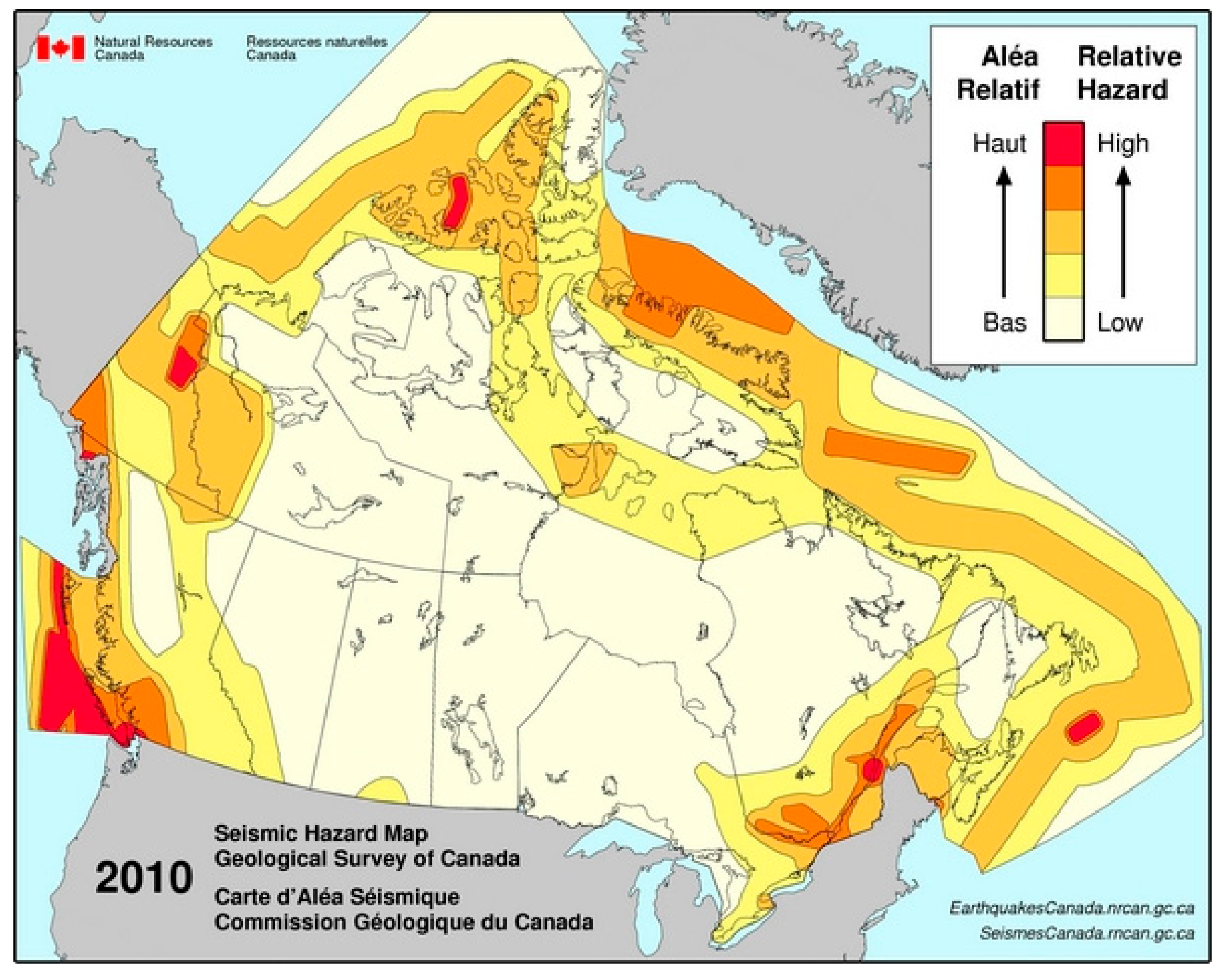
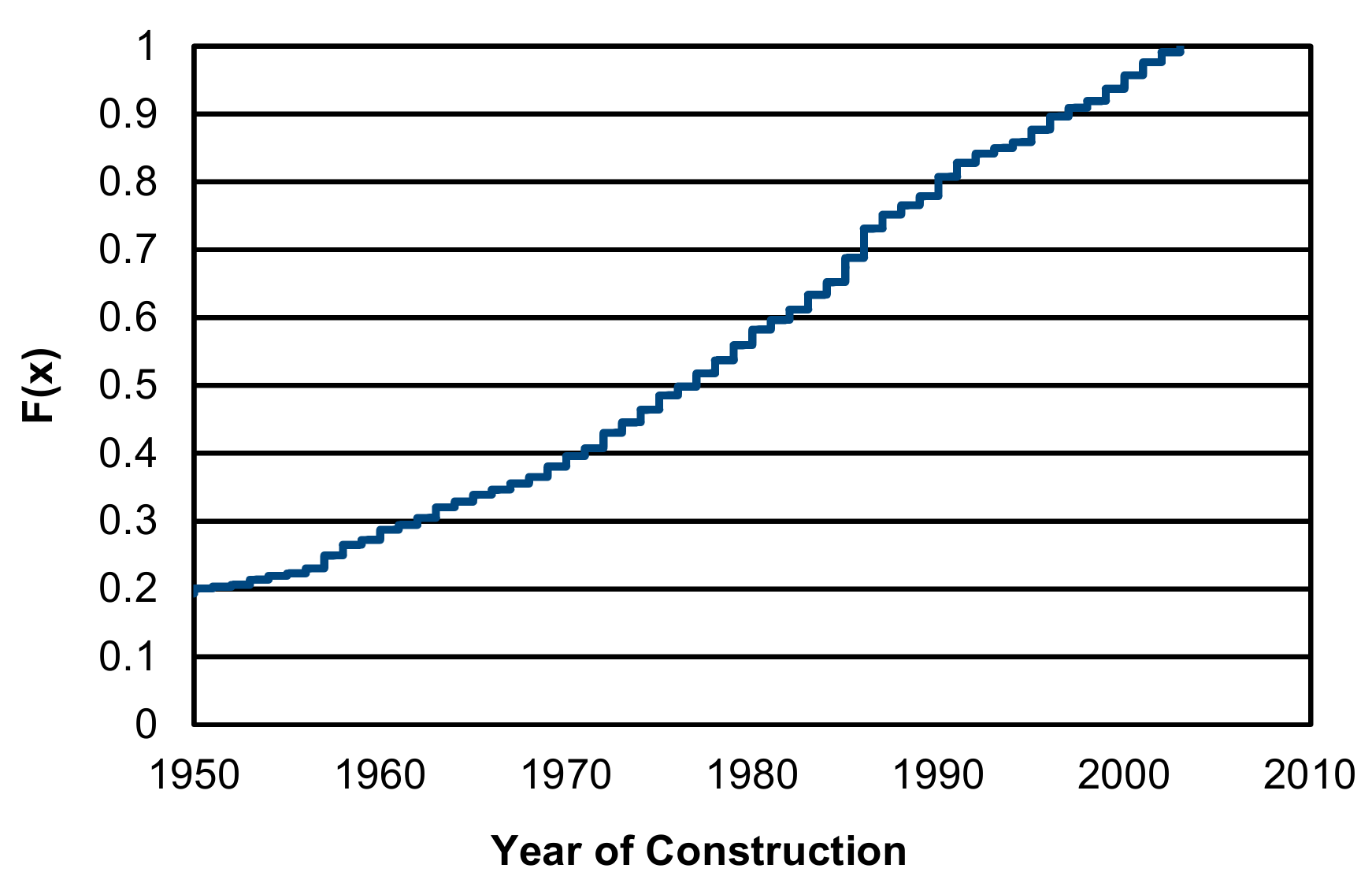

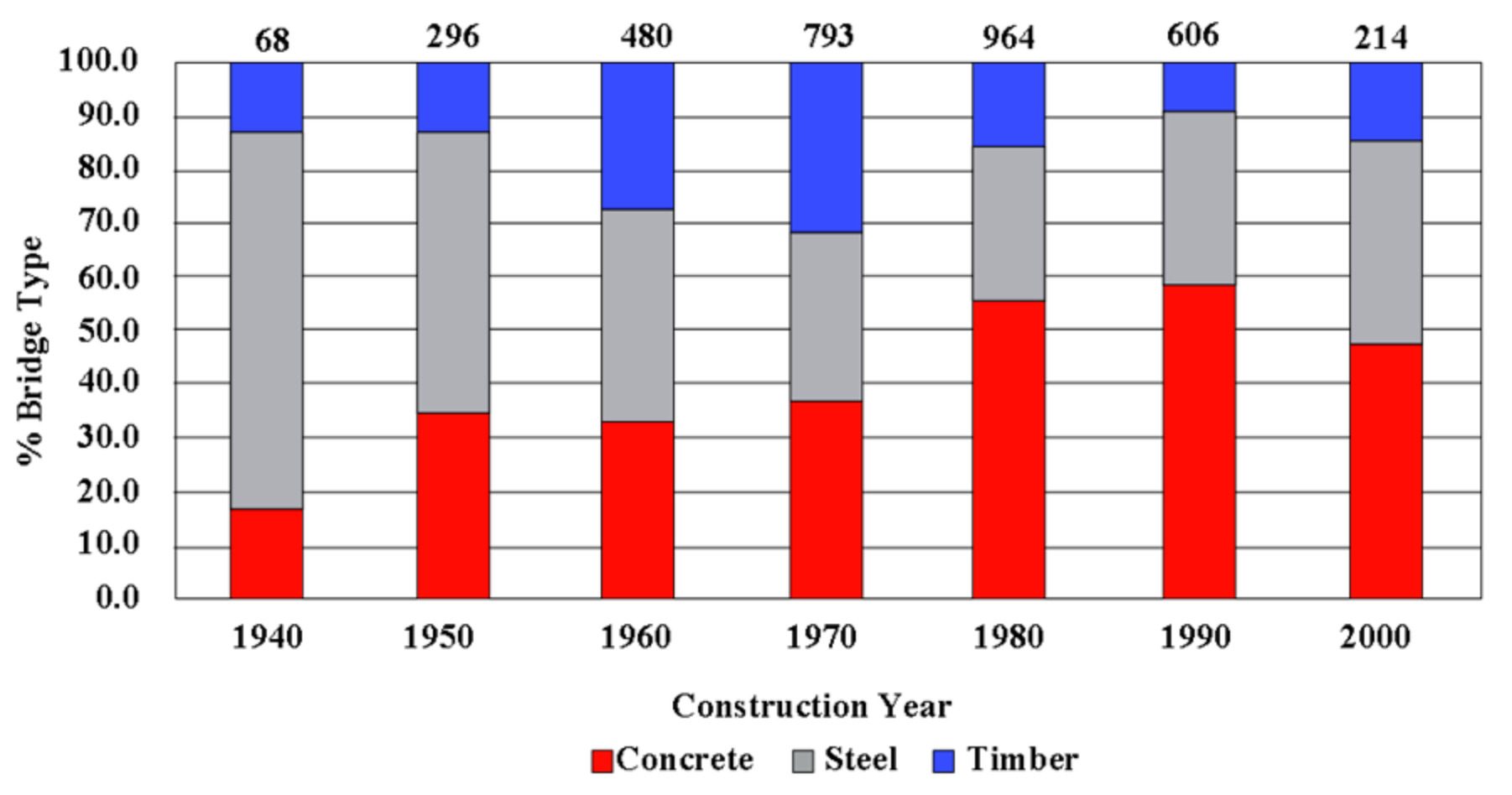
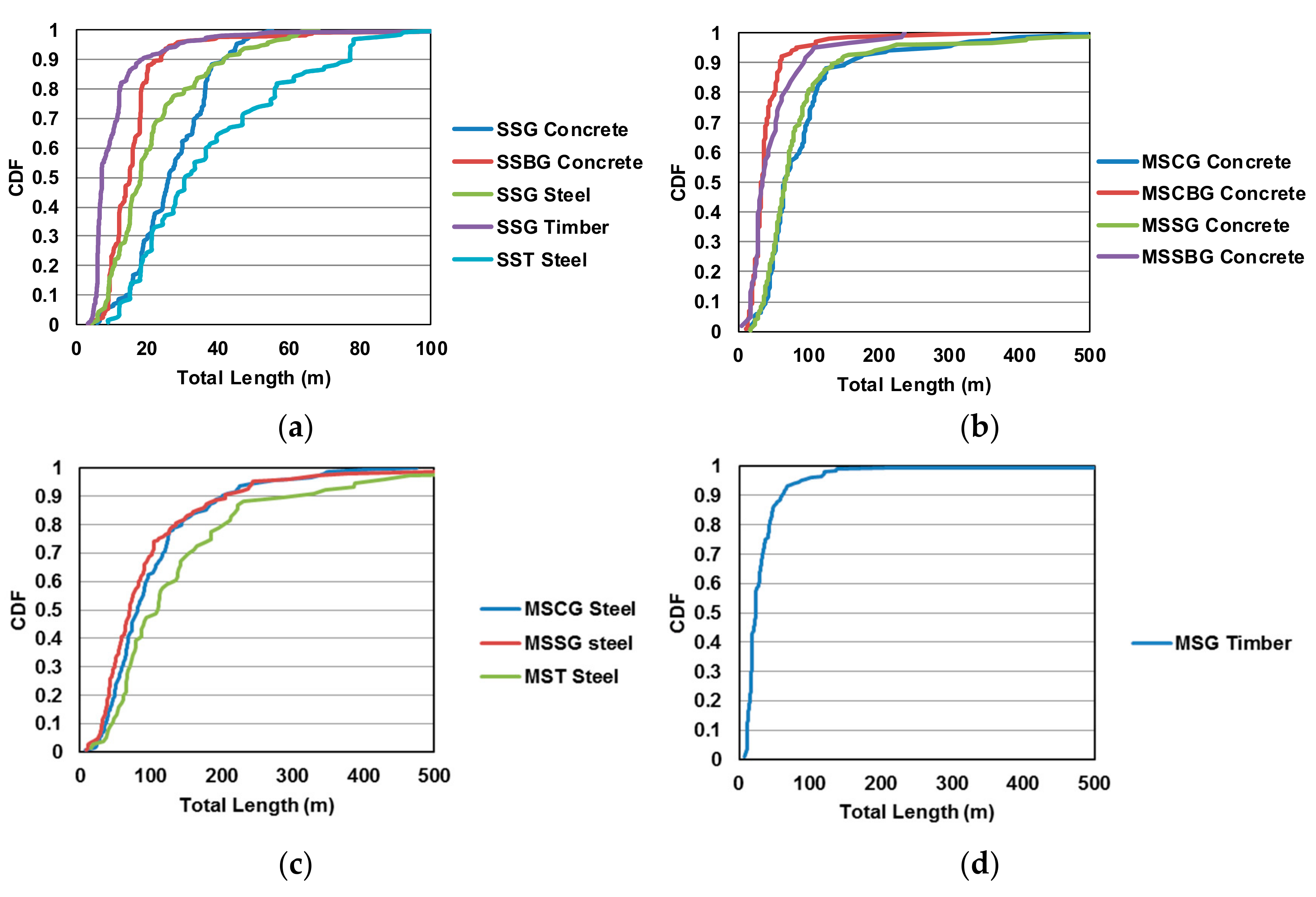


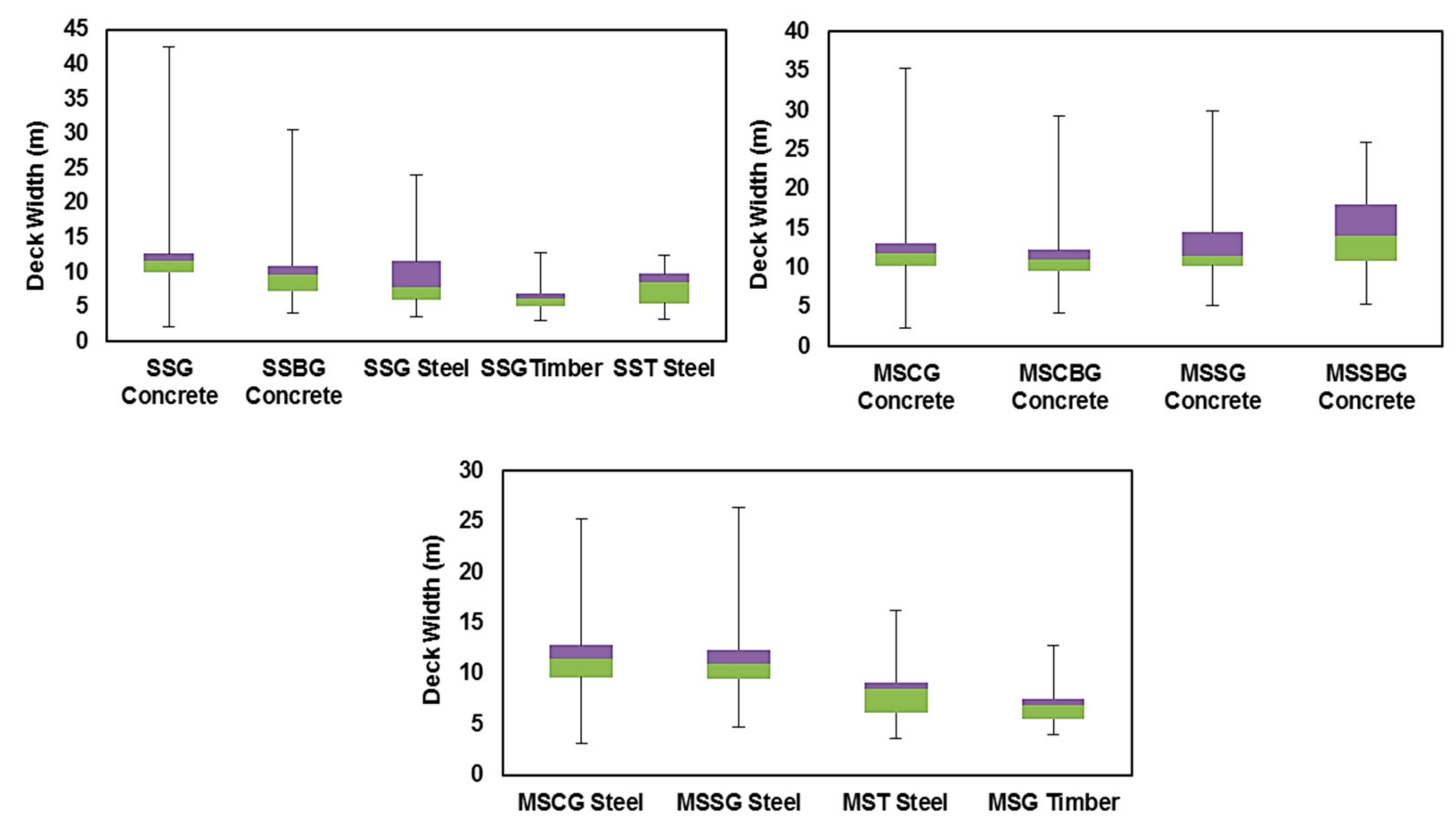

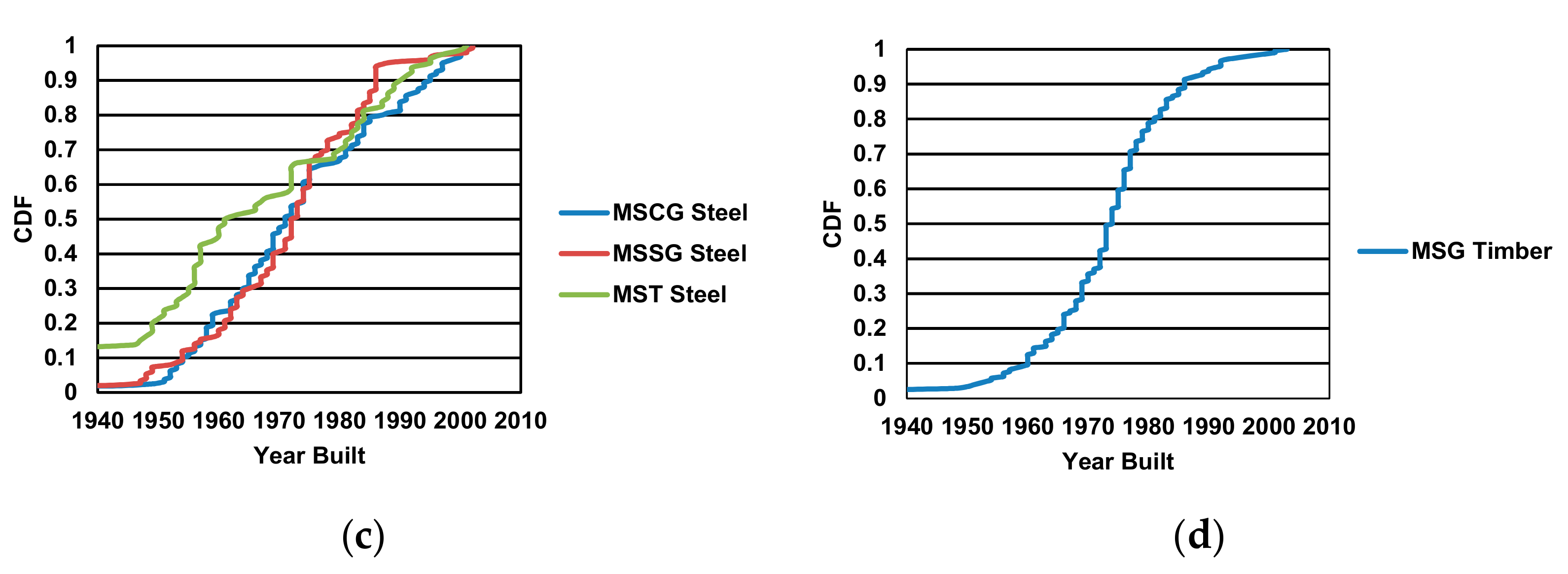
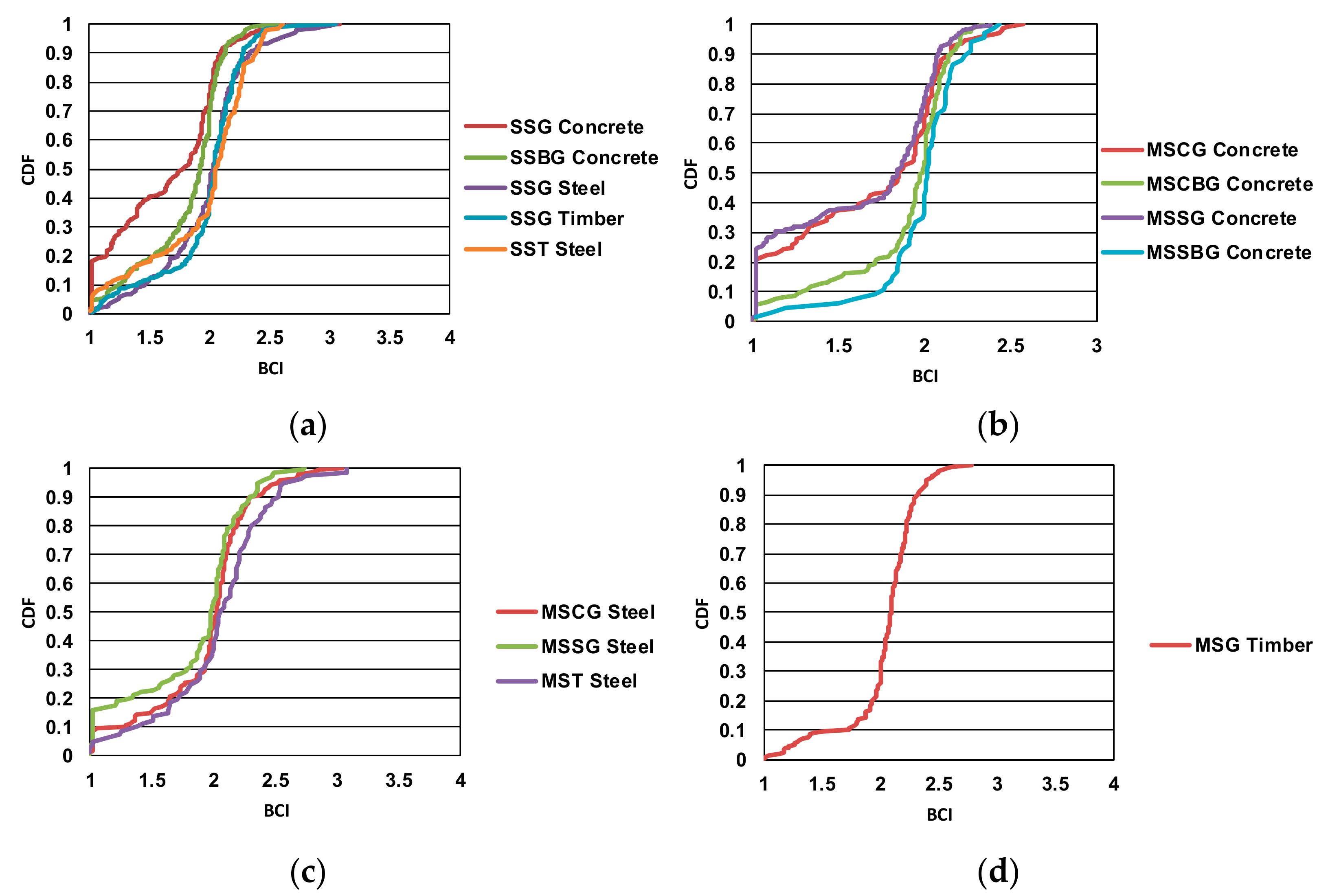

| SL. No. | Contract Area | Total Bridges | % of Bridges | SL. No. | Contract Area | Total Bridges | % of Bridges |
|---|---|---|---|---|---|---|---|
| 1 | South Island | 106 | 4.0 | 15 | Thompson | 94 | 3.5 |
| 2 | Central Island | 124 | 4.7 | 16 | South Cariboo | 87 | 3.3 |
| 3 | North Island | 179 | 6.7 | 17 | Central Cariboo | 121 | 4.6 |
| 4 | Howe Sound | 133 | 5.0 | 18 | North Cariboo | 64 | 2.4 |
| 5 | Sunshine Coast | 24 | 0.9 | 19 | Fort George | 64 | 2.4 |
| 6 | Lower Mainland | 172 | 6.5 | 20 | Robson | 52 | 2.0 |
| 7 | Fraser Valley | 204 | 7.7 | 21 | South Peace | 111 | 4.2 |
| 8 | South Okanagan | 116 | 4.4 | 22 | North Peace | 86 | 3.2 |
| 9 | Kootenay Boundary | 78 | 2.9 | 23 | Nechako | 33 | 1.2 |
| 10 | Central Kootenay | 148 | 5.6 | 24 | Lakes | 34 | 1.3 |
| 11 | East Kootenay | 97 | 3.7 | 25 | Bulkley Nass | 94 | 3.5 |
| 12 | Selkirk | 72 | 2.7 | 26 | Skeena | 95 | 3.6 |
| 13 | Okanagan-Shuswap | 114 | 4.3 | 27 | North Coast | 43 | 1.6 |
| 14 | Nicola | 75 | 2.8 | 28 | Stikine | 34 | 1.3 |
| SL. No. | Construction System | SL. No. | Construction System |
|---|---|---|---|
| 1 | Rectangular Girder | 7 | Suspension |
| 2 | Box Girder | 8 | Cable Stayed |
| 3 | I Girder | 9 | Balanced Cantilever |
| 4 | Truss-Through | 10 | Tunnel/Culvert |
| 5 | Truss-Deck | 11 | Miscellaneous |
| 6 | Structural Arch |
| SL. | Type | Abbreviation | Number | % |
|---|---|---|---|---|
| 1 | Single Span Concrete Girder Bridge | SSG Concrete | 218 | 8.5 |
| 2 | Single Span Concrete Box Girder Bridge | SSBG Concrete | 347 | 13.6 |
| 3 | Single Span Steel Girder Bridge | SSG Steel | 233 | 9.1 |
| 4 | Single Span Steel Truss Bridge | SST Steel | 138 | 5.4 |
| 5 | Single Span Timber Girder Bridge | SSG Timber | 301 | 11.8 |
| 6 | Multispan Continuous Concrete Girder Bridge | MSCG Concrete | 147 | 5.8 |
| 7 | Multispan Continuous Concrete Box Girder Bridge | MSCBG Concrete | 160 | 6.3 |
| 8 | Multispan Simply Supported Concrete Girder Bridge | MSSG Concrete | 252 | 9.9 |
| 9 | Multispan Simply Supported Concrete Box Girder Bridge | MSSS Concrete | 62 | 2.4 |
| 10 | Multispan Continuous Steel Girder Bridge | MSCG Steel | 165 | 6.5 |
| 11 | Multispan Simply supported Steel Girder Bridge | MSSG Steel | 153 | 6.0 |
| 12 | Multi Span Timber Girder Bridge | MSG Timber | 211 | 8.3 |
| 13 | Multi Span Steel Truss Bridge | MST Steel | 80 | 3.1 |
| 14 | Others | 88 | 3.4 | |
| Total | 2555 | 100.0 |
| Bridge Type | Mean (deg) | Median (deg) | Std. Dev. (deg) | 0° (%) | 1–15° (%) | 16°–30° (%) | 31°–45° (%) | >45° (%) |
|---|---|---|---|---|---|---|---|---|
| SSG Concrete | 11.5 | 0 | 14.8 | 51.9 | 12.6 | 24.4 | 11.1 | 0 |
| SSBG Concrete | 7.8 | 0 | 11.9 | 66.3 | 9.82 | 20.9 | 3 | 0 |
| SSG Steel | 8.8 | 0 | 15.5 | 70.17 | 5.3 | 10.5 | 11.4 | 2.6 |
| SSG Timber | 6.5 | 0 | 11.5 | 66.4 | 16.4 | 9.4 | 7.8 | 0 |
| SST Steel | 1.6 | 0 | 6.6 | 94 | 2 | 2 | 2 | 0 |
| MSCG Concrete | 10.8 | 2 | 14.2 | 50 | 19 | 18 | 13 | 0 |
| MSCBG Concrete | 6.8 | 0 | 11.1 | 67.4 | 9 | 21.3 | 2.25 | 0 |
| MSSG Concrete | 11.9 | 2 | 15.1 | 49.7 | 15.2 | 18.3 | 15.7 | 1.1 |
| MSSBG Concrete | 7.7 | 0 | 14.7 | 69.7 | 9.1 | 12.1 | 6.1 | 3 |
| MSCG Steel | 8.9 | 0 | 15.8 | 72 | 5.6 | 7.2 | 12.8 | 2.4 |
| MSSG Steel | 6.7 | 0 | 14.1 | 75.6 | 6.7 | 7.6 | 7.6 | 2.5 |
| MST Steel | 2.8 | 0 | 9.2 | 85.7 | 4.76 | 4.76 | 4.76 | 0 |
| MSG Timber | 6.9 | 0 | 14.0 | 74.6 | 4.76 | 12.7 | 6.35 | 1.6 |
| BCI/CS | Condition State | Summarized Description | Number of Bridges | Percent |
|---|---|---|---|---|
| 1 | E—Excellent | As new Condition | 549 | 19.5% |
| 2 | G—Good | Normal deterioration, maintenance not required | 1888 | 67.1% |
| 3 | F—Fair | Minor defects or collision damage, maintenance required | 365 | 13.0% |
| 4 | P—Poor | Significant defects or advanced deterioration, repair required | 12 | 0.4% |
| 5 | V—Very Poor | Serious defects, imminent failure of components, immediate repair required | 1 | 0.0% |
| Grand Total | 2815 | 100.0% |
| SL. No. | Pier Type | Number of Bridges | % of Bridges |
|---|---|---|---|
| 1 | Single Column | 11 | 0.85 |
| 2 | Flared Column | 77 | 5.96 |
| 3 | Multi Column Bent | 283 | 21.89 |
| 4 | Pile Bent | 178 | 13.77 |
| 5 | Pile Bent with Concrete Diaphragm | 96 | 7.42 |
| 6 | Steel Bent | 36 | 2.78 |
| 7 | Solid Wall Pier of Uniform Cross Section | 119 | 9.20 |
| 8 | Solid Wall Pier of Varying Cross Section | 85 | 6.57 |
| 9 | Hammerhead or Tee Type Wall Pier | 35 | 2.71 |
| 10 | Timber Pier | 272 | 21.04 |
| 11 | Others/Information not available | 103 | 7.97 |
| Total | 1295 | 100.00 |
| SL. No. | Pier Type | MSCG Concrete | MSCBG Concrete | MSSG Concrete | MSSBG Concrete | MSCG Steel | MSSG Steel | MST Steel | MSG Timber |
|---|---|---|---|---|---|---|---|---|---|
| 1 | Single Column | 4.2 | -- | 0.8 | -- | 0.6 | 0.7 | 1.2 | -- |
| 2 | Flared Column | 6.9 | -- | 8.7 | 1.5 | 8.1 | 15.0 | 1.2 | -- |
| 3 | Multi Column Bent | 31.3 | 5.0 | 34.1 | 27.3 | 24.2 | 30.1 | 16.0 | 0.5 |
| 4 | Pile Bent | 16.0 | 31.3 | 15.5 | 31.8 | 10.6 | 6.5 | 6.2 | 3.3 |
| 5 | Pile Bent with Concrete Diaphragm | 14.6 | 15.0 | 10.3 | 9.1 | 3.1 | 3.9 | 6.2 | -- |
| 6 | Steel Bent | 0.7 | 0.6 | -- | 1.5 | 11.2 | 2.0 | 4.9 | 1.4 |
| 7 | Solid Wall Pier of Uniform Cross Section | 7.6 | 3.8 | 3.2 | 4.5 | 16.8 | 17.0 | 24.7 | 0.9 |
| 8 | Solid Wall Pier of Varying Cross Section | 4.2 | 2.5 | 16.3 | 1.5 | 6.2 | 5.9 | 9.9 | 1.4 |
| 9 | Hammerhead or Tee Type Wall Pier | 0.7 | 1.3 | 4.0 | 1.5 | 5.0 | 7.8 | 1.2 | -- |
| 10 | Timber Pier | 7.6 | 26.3 | 2.0 | 18.2 | 6.2 | 3.3 | 6.2 | 78.2 |
| SL. No. | Pier Type | Concrete Pile | Steel H Pile | Steel Pipe Pile | Steel Pipe Pile Filled With Concrete | Timber or Log Pile | Single Column Footing | Combined Footing | Wall Footing |
|---|---|---|---|---|---|---|---|---|---|
| 1 | Single Column | -- | 18.2 | 36.4 | -- | -- | 36.4 | -- | -- |
| 2 | Flared Column | 1.3 | 24.7 | 13.0 | 1.3 | 6.5 | 40.3 | -- | -- |
| 3 | Multi Column Bent | 2.5 | 7.1 | 8.2 | 3.9 | 8.5 | 19.9 | 19.9 | -- |
| 4 | Pile Bent | 11.8 | 17.4 | 50.0 | 11.2 | -- | -- | -- | -- |
| 5 | Pile Encased Pier | 1.0 | 6.3 | 61.5 | 30.2 | -- | -- | -- | -- |
| 6 | Steel Bent | -- | 18.9 | 2.7 | -- | -- | 27.0 | 27.0 | -- |
| 7 | Solid Wall Pier of Uniform Cross Section | 0.8 | 13.4 | 13.4 | 1.7 | 8.4 | -- | -- | 27.7 |
| 8 | Solid Wall Pier of Varying Cross Section | 3.5 | 17.6 | 7.1 | 1.2 | 18.8 | -- | -- | 27.1 |
| 9 | Hammerhead or Tee Type Wall Pier | -- | 22.9 | 5.7 | -- | -- | -- | 2.9 | 54.3 |
| 10 | Timber Pier | -- | -- | -- | -- | 96.3 | -- | 3.7 | -- |
© 2017 by the authors. Licensee MDPI, Basel, Switzerland. This article is an open access article distributed under the terms and conditions of the Creative Commons Attribution (CC BY) license (http://creativecommons.org/licenses/by/4.0/).
Share and Cite
Siddiquee, K.; Alam, M.S. Highway Bridge Infrastructure in the Province of British Columbia (BC), Canada. Infrastructures 2017, 2, 7. https://doi.org/10.3390/infrastructures2020007
Siddiquee K, Alam MS. Highway Bridge Infrastructure in the Province of British Columbia (BC), Canada. Infrastructures. 2017; 2(2):7. https://doi.org/10.3390/infrastructures2020007
Chicago/Turabian StyleSiddiquee, Kader, and M. Shahria Alam. 2017. "Highway Bridge Infrastructure in the Province of British Columbia (BC), Canada" Infrastructures 2, no. 2: 7. https://doi.org/10.3390/infrastructures2020007






